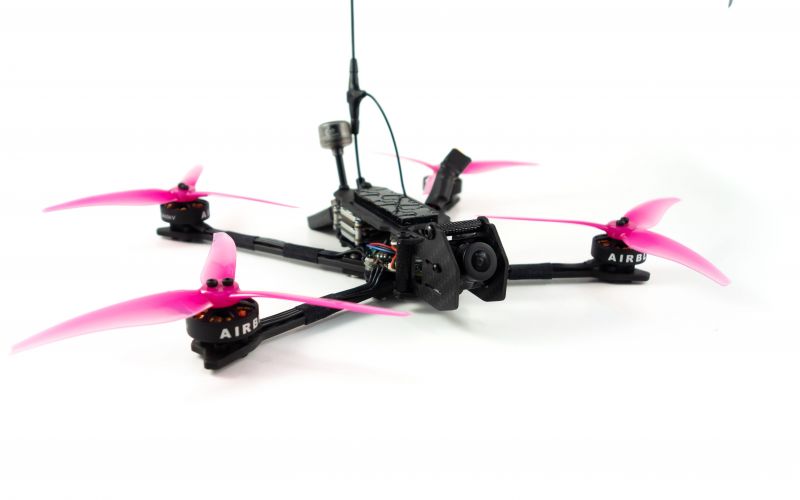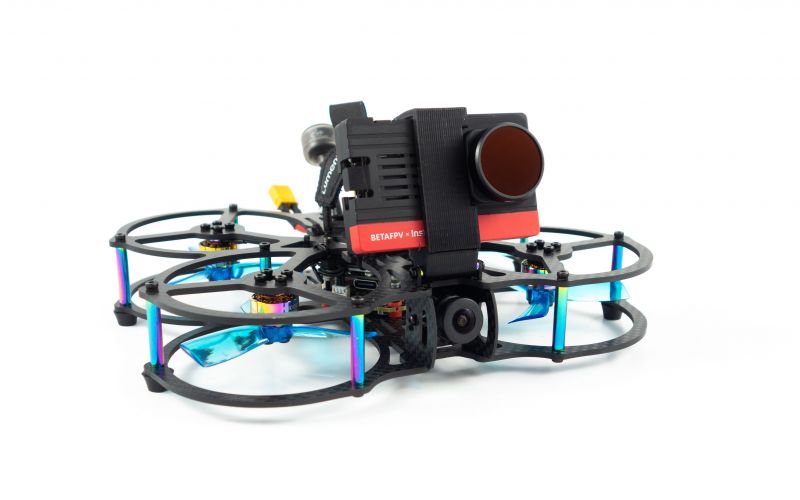My goal is to design a high speed HD freestyle quad that;
1 - performs well
2 - is easy to work on, and
3 - durable.
1 - Performance
Geometry - After flying many different types off frame shapes; deadcat, squashed x, stretched x, and true x; it’s apparent to me that true x feels the most balanced because both roll and pitch rotate at the same rates.
Bottom battery - This position gives the quada lower center of gravity so it feels like it wants to naturally help us self level without needing to rely on angle mode. In order to protect the battery, I opted to use a lipo protector which features a built-in 30° launch platform.
Interlocking arms - interlocking arms increases durability and creates a structure that is incredibly strong. There is zero shaking.
2 - Ease of use
Minimal hardware - Unlike most freestyle frames, my design uses the minimal amount of screws which make repairs easier and less time consuming to do. This also means that we don’t have to carry around as much spare parts and hardware when we’re in the field.
Clip on shoes - I am using a TPU shoe design that clips on without using screws. This means that you will not crush TPU over time with motor screws which will either loosen your motors or become too long which ends up digging into your motor coil.
Plate holes - My upper plate holes allow flexibility for mounting options for your electronics such as receivers and buzzers. There are also holes that allow two zip ties to secure the DJI Air Unit as well as holding the fin down. This frame will support 30x30 and 20x20 stacks. It will fit the DJI Air Unit O3, DJI Air Unit 1, and Vista. You can download the TPU files below for your specific video system.
3 - Durability
T700 Carbon Fiber - Most frames use T300 carbon fiber to make frames more affordable. T700 carbon fiber is 38.8% stronger. The tensile strength of T300 carbon fiber is 512 ksi. The tensile strength of T700 carbon fiber is 711 ksi. The cost of T700 carbon fiber is 30.8% more than T300. On the field if you break an arm and or a body plate, the time and inconvenience is worth more than the difference in cost for the better material. You can read more about T700 CF here.
M5 hardware - Most true x quads that hold an Air Unit only uses a Nylon canopy. However it's still plastic so in hot weather, it can soften. Since most true x frames are geared towards racing they do this to save a little weight. I want more durability so my design protects the Air Unit completely by having it mounted inside the frame between T700 carbon fiber plates. M5 hardware is 5mm in diameter so when you crash, the standoffs will not deform or break so easily like the typical M3 hardware would.
Motor protection - I have never found a disadvantage in protecting your motors at the expense of adding a little more weight.
Turtle Fin - This increases our opportunities to perform the flip over after crash feature. It also protects the camera and Air Unit antenna(s).
Antenna position - center mounting the Crossfire antenna is the best way to protect it.
Capacitor and Fettec Spike absorber - Using silicone tape around the capacitor and spike absorber helps protect the Air Unit and XT-60 connector by giving it flexibility. Soldering wires to the capacitor makes it more durable than soldering it directly onto the ESC.
Race wire - Race wires are a tiny bit lighter than wires. There’s more soldering initially but they prevent prop strikes to motor wires. They also make replacing motors easier. The LED versions are fun for low light situations.
Props out- The reason I run props out is to protect my camera lens and keeping it clean.
Build notes
4S gives me more control resolution and saves money on batteries. They are slightly lighter which also increases performance. I flashed Bluejay ESC firmware to get Bidirectional Dshot, RPM Filtering, and Dynamic Idle features in Betaflight. Running Betaflight 4.3. My crossfire nano rx is mounted on the back of the top plate using VHB 3M double sided tape and the rear zip tie. The Air Unit is mounted the same way but uses two of the center zip ties. The buzzer is mounted in the same way in front of the Air Unit. I'm using Xilo 4s 1500mah lipos and Gemfan f3s 5130 props. Body plates are 3mm thick. Arms are 6mm thick so standard motor screws should fit perfectly. I'm using a 250mm battery strap. I wrap my crossfire nano rx with Kapton tape after soldering the wires on. I use the thick Ummagrip sticky battery pad under the bottom plate. There is no props in view on the Gopro when set to wide mode on 8:7, 5.3k. And yes you can remove the fin and gopro mount entirely and fly it in it's most minimal form also. This frame fits up to 5.5" props. The photos of the build with the Gopro 12 are on 5.5" props.
The TPU parts I designed are available here.
If you don't have a printer, I recommend you have Brain3d print them. My camera angle is 35% with only a little bit of props in view in 4:3 aspect ratio.
Maiden flight is here using Betaflight default pids.
https://www.youtube.com/watch?v=ydHwSwKIl5E&t=68s
About the frame:
https://youtu.be/nn0SUJAXc-k?si=2GGj8IrrOWgSJZ_B
Creality Ender 3 S1 Pro TPU profile
https://www.dropbox.com/scl/fi/jzm53kbesq686mqs7mqh2/TPU_Mangorille.curaprofile?rlkey=326vtfydxyicdcq4b6fn2na9g&st=a6e1ba27&dl=0
Photos
Part List
Show stores (8)Guides & Reviews
AirbladeUAV has done it again and this time they've brought long range to the 5" class! Based on the popular Transformer Mini, the new Transformer 5" Ultralight adopts a lot of the same design philosophies with larger props and more payload capacity. It can fly upwards of 20 minutes on a 4 cell Li-Ion battery pack and in ideal conditions it's got a range of over 4 to 5 miles. In this guide I'll walk..
Read moreWith the release of the DJI FPV Drone cinematic FPV has become a lot more accessible, but you certainly don't want to crash a $750 drone! The QAV-CINE Freybott is a compact, lightweight cinematic FPV drone that can take a hit and keep going. It's a lot safer to fly indoors and around people. With a naked GoPro or the SMO 4k you can capture some great stabilized footage. In this guide I'll show you..
Read more



















































Amazing build. It is almost like you are reading in my ming. I was always thinking why not to put freestyle equipment into racing platform. Also very good and detailed description. Thanks you for sharing this